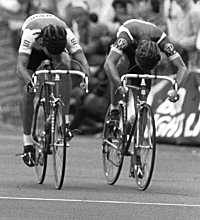Designing a Training Program
Effective coaching must be holistic, individualized and iterative. It involves:
- Information -- what specific info is needed about the athlete
- Structure
- Components.
Three pieces of information are needed:
- The athlete's training and competition history; this helps determine the proper training load
- The current fitness level, which can be determined by a test, such as a time trial or field test
- The athletes goals.
Training Structure
A long-term, periodization plan.
- Prescribes training periods with specific training and racing goals
- Addresses psychological issues
- Is not limiting or overly strict because the reality of training and competition is dynamic; the plan must be flexible.
Carmichael puts emphasis on psychology early and loosens up the structure as peak approaches.
Macrocycle
- Largest unit of the training plan
- 12 months is standard length
- Structuring a macrocycle must begin with defining the length of the competition period
- Goals of the macrocycle are then defined
- Key question is what are the predominant energy systems and/or competition demands of the event?
Mesocycle
- Generally six to eight weeks, occasionally as long as 12 but this is pushing it; a shorter cycle helps keep the athlete focused
- Determine quantity of mesocycles in the macrocycle
- Then establish general training volume, intensity, skills and competitions in each mesocycle
- Each mesocycle includes progressive overload and recovery, targeting the development of specific energy systems
- After a certain point the athlete will begin to achieve only diminishing returns from training; this is time to switch to a new mesocycle with a different emphasis.
Typical Weekly Volume for Eight-Week Mesocycle | |
|---|---|
| Week | Volume relative to week seven |
| 1 | 40% |
| 2 | 55% |
| 3 | 75% |
| 4 | 50% |
| 5 | 65% |
| 6 | 85% |
| 7 | 100% |
| 8 | Depends on goal |
Microcycle
- Generally structured around a single week for simplicity
- CTS training components are applied each day.
Typical Daily Volume for Seven-Day Microcycle | ||
|---|---|---|
| Day | Volume relative to day seven | Purpose |
| 1 | 55% | Recover |
| 2 | 60% | Build |
| 3 | 70% | Build |
| 4 | 90% | Build |
| 5 | 50% | Recover |
| 6 | 75% | Build |
| 7 | 100% | Maximum |
Building period of longer than three days often gives diminishing returns and serious problems for recovery/adaption.
An alternate system might have two days of building, followed by a single day of recovery in alternating blocks.
The 100% number is an estimate and other volumes are set by working back from this estimate. In any case, avoid increase of more than 10% from one microcycle to the next.
Total Training Stress
Total training stress is a combination of all loading factors. The ratio of volume to intensity must build progressively throughout the mesocycle.
Adaptation occurs only during recovery.
Total training stress is greatest in the preparation period. It should decline as competition begins.
Psychological demands and pressures must be considered as part of the total training stress.
Peaking
Training must create the same demands as racing.
Training volume over LT is critical but destructive if overdone. It must be monitored closely with a heartrate monitor or other means.
Unresolved psychological issues will be magnified during the peaking period.
Most of the critical training will have been done before entering peaking phase.
Training Components
 |
Carmichael (right) takes second in the 1987 La Jolla Grand Prix behind Jeff Pierce. Richard Bryne photo |
The variables include.
- Intensity
- Volume
- Frequency and repetition
- Terrain
- Cadence and technique.
Intensity
It can be measured by how fast the rider goes, how much power is produced, or HR. These objective measures are important but subjective measures -- how the athlete feels -- are key in spotting overtraining.
Volume
Volume is the amount of training performed in a specific workout or certain period of time. It can be measured in hours or miles; hours are generally more accurate but it's best to keep track of both.
Are longer rides better? That depends on intensity of the ride and the goals of the training period.
Frequency and Repetition
Frequency is how often a workout is performed. Repetition is the number of exercises in a particular workout.
Frequency of workouts is reduced as the athlete gets closer to a specific goal.
Repetitions must be considered as part of the training load.
Terrain
Different terrains stress the muscles in different ways. HR intensity must take terrain into consideration. HR will be higher at a given intensity on hillier terrain.
Cadence and Technique
Special rules in riding, such as not allowing oneself out of the saddle or maintaining a certain cadence, can also contribute to overload. In early season training for some of his athletes, Carmichael does not allow them to ride out of the saddle on hills.
Pedalling at a high cadence is a learned neuromuscular skill. Different cadences will affect training intensity. High cadence puts additional stress on the aerobic system. Individual riders respond differently to different pedalling speeds.
Generally the more steady state the event, the lower the proper cadence. Also, the higher the power output, the higher the proper cadence. The longer the cranks, the slower the cadence.
| Previous | Next |
Introduction | Carmichael Training System | Designing a Training Program
Resistance Training | Establishing Training Intensities Using Heart Rate
Notes hosted by Century-SBCG.
